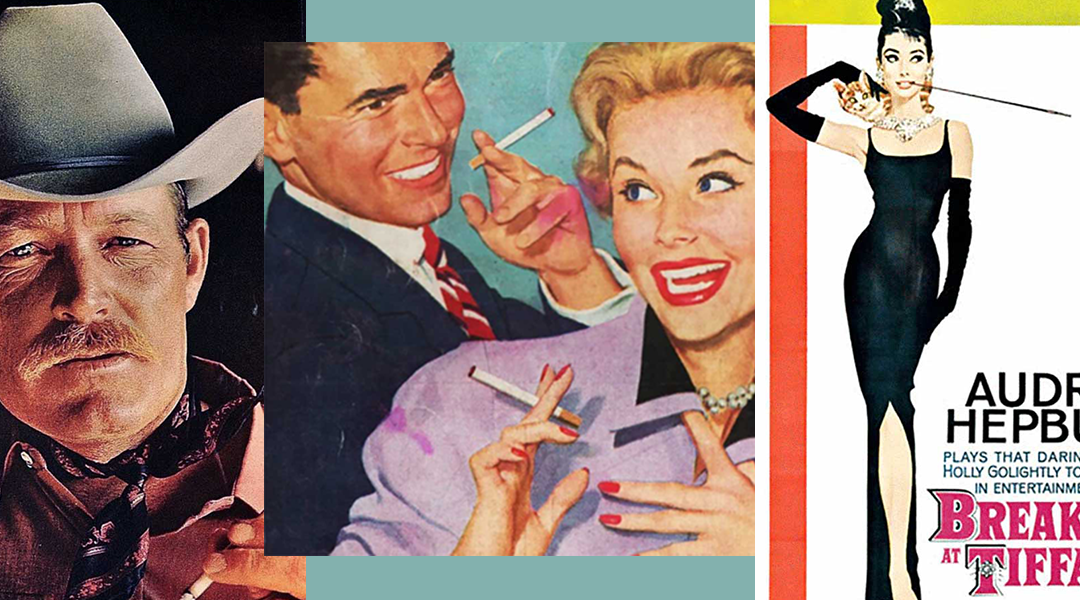If there’s one thing advertising in the 1950s and ‘60s, The “Marlboro Man”, “Breakfast at Tiffany’s.” (Image courtesy of Pinterest)
November 2024
Everything Old
Smoke ‘em if ya got ‘em
by Corbin Crable
Until the mid-1960s
Until the mid-1960s, the act of smoking was an everyday part of our daily lives.
Whether at work, mowing the lawn, preparing dinner in the kitchen, or driving the kids to school, it seemed like everywhere you looked, you saw an adult puffing away on a cigarette. For decades, the mass media’s effort to craft generations of smokers was aggressive and ever-present. Magazine advertisements quoted doctors who convinced us that smoking was actually beneficial for your health. Entire radio and television programs were sponsored by brands such as Lucky Strike. At the movies, film stars like Cary Grant and Joan Crawford made smoking look sophisticated and fashionable. Cigarettes and their influence were synonymous with the routines of our daily lives. We were, as one company so aptly exclaimed, a society “alive with pleasure!”
All of that changed in 1966, when the first warning labels about smoking’s risks were slapped onto packs of cigarettes; the following year, the first tobacco control media campaigns hit the airwaves. A group called Action on Smoking and Health filed a complaint with the Federal Communications Commission, arguing under the FCC’s Fairness Doctrine that TV and radio stations had to allow just as much airtime for anti-smoking messages as they did for their tobacco advertisers.
Centers for Disease Control and Prevention
A few years later, the Centers for Disease Control and Prevention recommended that each state earmark money to specifically educate the public on the dangers of smoking (the first statewide anti-tobacco campaign was launched in 1982 in Minnesota). It would prove difficult to take on Big Tobacco, whose pockets seemingly had no bottom, thanks to the influence of political lobbyists at higher levels of government.
Even more difficult is the emergence of characters like Joe Camel, the brainchild of RJ Reynolds Tobacco Co., invented in 1984 for their cigarette brand Camel. Designed to appeal to children, a 1991 study found that Joe Camel was just as familiar to children as the Walt Disney Channel’s logo.
For adults, the Marlboro Man came along in the mid-20th century, following decades of Marlboro cigarettes being marketed to women as slim and flavorful. The image of the rugged cowboy appealed to a man’s masculine nature, and the character became the face of the company for the next several decades.
Myriad forms of Harm inherent in smoking
Now, given what we know about the myriad forms of harm inherent in smoking, such aggressive advertising campaigns have receded into the background of our mass media – or, perhaps more accurately, their disappearance from TV and magazines is due to brands like Marlboro, Camel, and others now being household names. Whatever the reason, the smoker’s shift to vaping in the past decade seems to be gaining attention. But the industry still hasn’t come up with campaign slogans or characters of cigarette companies of yore that can compete with their predecessors.
In this issue, we’ll explore a few vintage tobacciana products, produced in the days before we knew about the dangers of smoking. Maybe you haven’t smoked in many years but used them yourself in your younger days. Whatever your memories, these items – like those we explore in every issue — represented a specific moment in time that won’t ever be captured again, for better or for worse.
So flick that Bic, smoke ‘em if you’ve got ‘em, and enjoy your brief visit to Flavor Country.


